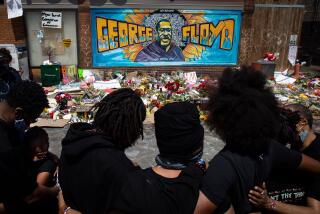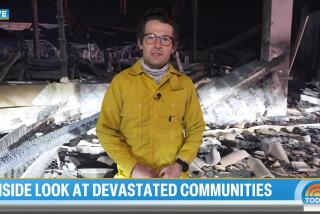TV News Feeds Fear of Unrest : Television: Stations are heating up coverage to grab ratings during two provocative trials. And the media may be coming ‘close to inciting a riot,’ says Channel 13’s Bill Press.
- Share via
“CIVIL WAR.”
That big, bold headline on the screen was followed by a warning from an African-American: “I think we have to kill some whites before they take us seriously.”
The above sequence appeared recently on KCOP-TV Channel 13’s “Real News.”
“And I thought to myself,” recalls Bill Press, the station’s own commentator, “is that what we’re calling for, civil war?”
With coverage heating up over the possibly overlapping Rodney G. King and Reginald O. Denny trials, is it the media that should be sequestered?
Still vivid is the memory of sometimes-inflammatory TV coverage of the Los Angeles riots that greeted last year’s acquittals of four white Los Angeles police officers who were tried in state court regarding the ferocious beating of King, an African-American. The same officers are now headed for a second trial in federal court, with the jury selection process under way.
Equally memorable are those TV pictures of the white Denny being yanked from his truck during the riots and savagely beaten by African-Americans (he was later rescued by African-Americans who had been watching the coverage). Three men are about to be prosecuted for attempted murder in that case.
But it’s the King trial that is now pushing the media’s button the hardest. And, as TV pictures show, lawyers in the case are being swarmed over by camera crews outside the courtroom, carnival music is in the air.
In a commentary last week, Press blasted pretrial coverage by television, finding “nobody . . . a worse offender than our own ‘Real News.’ ” He also criticized coverage by The Times and radio.
Given last April’s post-King trial anarchy in the streets, it’s appropriate for media to speculate about what might happen should the second trial produce more acquittals. And it also makes journalistic sense to report fears in the community about possible renewed rioting, as KABC-TV Channel 7 did last week regarding increased gun purchases by Korean-Americans, some of whom were the hardest hit during looting.
Yet reporting a community’s state of mind is one thing, shaping it through news coverage is another. As always, the media have to make tough choices in finding a balance between responsible reporting and dangerous reporting.
Where some have “crossed the line,” Press charged on the phone, “is in going out and assuming there’s going to be more riots. They’re egging it on, going out into the community and asking people, ‘What are you going to do this time when the trouble comes?’ That’s not reporting on the possibility of a riot. That comes close to inciting a riot.”
Press went further in his commentary, suggesting even that some media members would be disappointed if there weren’t rioting.
Last year’s riots have become one of the city’s indelibly dark memories, understandably elevating cynicism, suspicion and fear. For example, a recent Los Angeles Times poll found 67% of the city expecting either the King or Denny verdict to spark more violence.
If there is a siege mentality in Los Angeles, however, local television itself has to share the blame.
When competing newscasts use crime stories to shoot wildly at each other from the hip, as a way of increasing ratings, viewers are inevitably caught in the cross-fire. As a caller to Steve Edwards’ KABC radio show noted Friday, local news is “a kind of body count. . . . It just scares people.”
Indeed. At a time when coolness is what L.A. desperately needs, most local newscasts continue to gratuitously load up on violent crime night after night, exaggerating, hyperventilating and whipping up emotions. Their constant portrayals of society as frighteningly wicked could have devastating results, splitting communities, heightening tensions and feeding citywide paranoia. There is just no excuse for it.
Nor, in the event of any future mass chaos in Los Angeles, would there be any excuse for coverage a la “Cops,” with TV news crews chasing down the street with their mobile minicams, automatically going live to capture the heat of the moment as if a city’s disintegration were some kind of “reality” entertainment show.
Live reporting can be crucial. For example, if some good Samaritans had not seen Bob Tur’s live chopper’s-view coverage of Denny getting clobbered at Florence and Normandie avenues (Tur was then at Channel 13), the trucker’s plight would have gone unspotted by outsiders, and he might have died.
More often, though, live coverage of volatile stories is runaway technology that has more potential for harm than good. That is especially so when it comes to soliciting live, potentially inflammatory eyewitness accounts that are not necessarily reliable.
In constantly emphasizing live coverage, TV’s message is that events not immediately reported, or not phonied up with live intros and “outros,” become antique. Yet “many stories . . . are better told when you have time to come back to the station . . . and think about it,” Channel 13 news director Jeff Wald said on Edwards’ show Friday. Thinking before speaking? That’s sounds almost musty in today’s environment of frenetic, instantaneous TV reporting that, during the riots, found some anchors making dangerous, saber-rattling snap judgments about what was occurring in live pictures flashed on the screen.
Wald noted, also, that few reporters “are really good at going live and really telling you anything.”
That’s especially true now in Los Angeles where some budget-minded stations have replaced old hands with lower-salaried, relatively inexperienced cubbies from much smaller markets, dramatically lowering the level of TV reporting here at a time when the number of newscasts is greater than ever.
Green reporters being tested by having to do live reports on the streets of a rioting city? That would be another trial that Los Angeles would never forget.
More to Read
The complete guide to home viewing
Get Screen Gab for everything about the TV shows and streaming movies everyone’s talking about.
You may occasionally receive promotional content from the Los Angeles Times.






